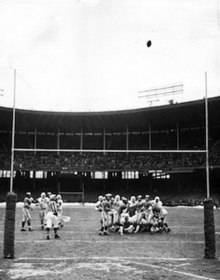Lou Groza
Groza's accuracy and strength as a kicker influenced the development of place-kicking as a specialty; he could kick field goals from beyond 50 yards (46 m) at a time when attempts from that distance were a rarity.
He enrolled at Ohio State University on a scholarship in 1942, but after just one year in college, he enlisted in the U.S. Army and was sent to serve in World War II.
[1][2][3] Lou was the smallest in stature of four boys in an athletic family; his brother Alex became a star basketball player at the University of Kentucky, a member of two national championship teams.
[5] Groza graduated from high school in 1942 and enrolled on an athletic scholarship at the Ohio State University in Columbus, where he played as a tackle and placekicker on the Buckeyes' freshman team.
[6] He first went for basic training to Abilene, Texas, and then to the Brooke Army Medical Center at Fort Sam Houston in San Antonio.
[6] After a stint with the short-lived Army Service Training Program, Groza was sent with the 96th Infantry Division to serve as a surgical technician in Leyte, Okinawa, and other places in the Pacific theater in 1945.
[10] There, he joined quarterback Otto Graham, fullback Marion Motley and receivers Dante Lavelli and Mac Speedie to form the core of the new team's offense.
[13] Behind a powerful offense led by Graham, Motley and Lavelli, the Browns finished the 1947 season with a 12–1–1 record and made it back to the championship game.
[5] Groza led the league in field goals and the team won all of its games in 1948, recording professional football's first perfect season.
[11] One highlight of that year for Groza was a 53-yard field goal against the AAFC's Brooklyn Dodgers that was then the longest kick in pro football history.
[17] Another championship win followed in 1949, but the AAFC dissolved after the season, and the Browns were among three teams absorbed by the more established National Football League (NFL).
[4] The war had shortened Groza's college career, so he continued to study at Ohio State in the offseason in his early years with the Browns.
[18] Groza married that year, to Jackie Lou Robbins, a girl from Martins Ferry who was working as a model in New York City when they first dated.
[23] The Rams went ahead early in the game on a touchdown pass from star quarterback Bob Waterfield and a scoring run by Dick Hoerner.
[34] Groza set a record in 1953 when he made 23 field goals and had an 88.5% success rate, a single-season mark that stood for 28 years.
[41] Groza's kicking continued to be a strength through the ensuing three years: he reached the Pro Bowl in 1957, 1958 and 1959, and tied Sam Baker for league leader in points scored in 1957.
[8] While his kicking was his most visible contribution to the team, Groza was also an offensive tackle up until his injury, when Brown replaced him with Dick Schafrath.
[50] After Groza retired, he entertained an offer to play for the San Francisco 49ers, but was reluctant to do so because he did not want to move his family and insurance business to the West Coast.
[55] He was offered a spot with the Browns as a kicking coach, helping mentor the young Don Cockroft, but he declined.
[55] Later in life, he became an ambassador and father figure for the Browns, inviting rookies over for dinner and helping them find apartments.
[50] He continued to run a successful insurance business and lived in Berea, Ohio near the Browns' headquarters and training facility.
[50] Modell relocated the Browns to Baltimore in 1995 and renamed the team the Ravens, provoking a wave of anger and disbelief from fans and former players.
[57] While field goals had long been viewed as an important part of football strategy, kicking specialists were a rarity before Groza's time.
[62] He set single-season NFL records for accuracy, distance and number of field goals in his first three years in the league, marks that went unbeaten until kicking specialists became a common feature of the game in the early 1970s.
[68][69] The Browns retired his number 76; he is also in the team's Ring of Honor, a grouping of the best players in the club's history whose names are displayed below upper-deck seats at FirstEnergy Stadium.
[70][71] In 1992, the Palm Beach County Sports Commission established the Lou Groza Award, given to the best National Collegiate Athletic Association Football Bowl Subdivision (formerly Division I-A) kicker.
[72] [73] One of his kicking shoes is part of the collection of the Smithsonian Institution in Washington, D.C.[57] In 2006, Lou was inducted into the National High School Hall of Fame for his athletic exploits in baseball, basketball & football at Martins Ferry High School where he earned 12 varsity letters and led the football and basketball teams to State championships.
In 1941 as a junior, Lou led the Martins Ferry High School basketball team to the class A championship.
In the State semi-final game against Xenia Central, he hit two free throws with no time left on the clock to secure the victory.
In 1941 as a senior, he led the Martins Ferry High School football team to a share of the State championship tying Toledo Libbey 14-14.




